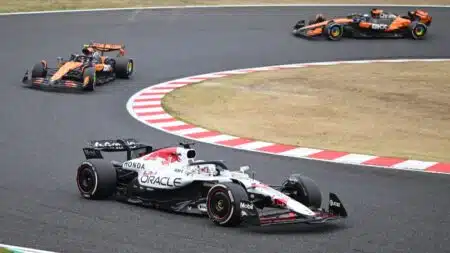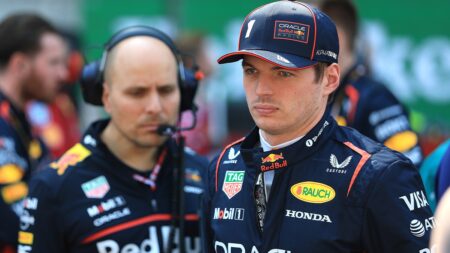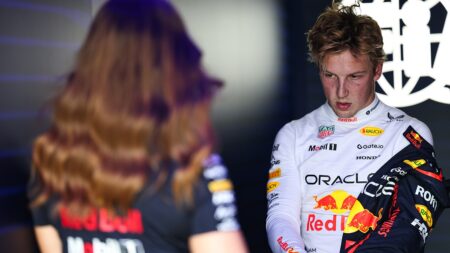Every now and then a new driver arrives in F1 with a ‘buzz’ around him, the suggestion that he is something out of the ordinary. So it is with Max Verstappen this year and it’s going to be one of the more fascinating aspects of the season watching how he develops in the Toro Rosso and whether he lives up to the heady expectation that accompanies him. Some do, some don’t. Ayrton Senna had already marked himself out as something very special as he arrived in 1984, a reputation he essentially justified at Monaco, his third race, by using his ordinary Toleman to hunt down the usually dominant McLaren of race leader Alain Prost.

Others have arrived with similar legend-in-the-making reputations from the junior categories but have then failed to fully translate into F1 whatever it was that marked them out lower down: the parents of two current drivers come to mind – Jos Verstappen and Jan Magnussen. Each were exciting talents, but didn’t back it up with enough thought or application when they arrived in the big time. Something didn’t quite click.

Magnussen at Jerez, 1997
Magnussen at Jerez, 1997 But at least Jos and Jan they got their chance in F1. Tragically Bertrand Fabi, the French-Canadian who might have filled the void left by Gilles Villeneuve’s passing, never did. In his very brief time he had already acquired that ‘buzz’ of being something very special from one incendiary season in FF2000, 1985. He was killed testing an F3 car at Goodwood early the following year. Dick Bennetts reckons him up there with his other F3 stars Ayrton Senna and Mika Häkkinen. Henrik Larsen, the Danish racing ace of the mid-late ’80s, puts Senna and Fabi as the two best drivers he raced against, with Häkkinen next. It’s impossible to judge these things in absolute terms, of course, but such opinions carry weight. Fabi was unquestionably extravagantly gifted, ruthlessly hard on track, bright, absolutely besotted with racing and had a wealthy career benefactor. It seems almost inconceivable that he wouldn’t have made it to F1 and difficult to think why he wouldn’t then have become one of its brightest stars.
“He was a very, very special person and a very special talent,” says Richard Dutton, whose team partnered Fabi in winning the ’85 British, European and Benelux FF2000 championships. “I’m often asked who the best driver I’ve ever run has been, whether it was Montoya perhaps. But no, for me, as the complete package Bert stands above anyone else. I have a picture of him on my kitchen wall to this day. He lived at my house until about three days before he died. He would sit up until the early hours and all he wanted to do was talk racing, analyse it, thinking about it – 100 per cent a professional racing driver and incredibly strong mentally. There was nothing else for him; it’s what he lived for. He had an amazing talent too. I really thought he would go on to become a huge F1 superstar. He was absolutely of the calibre of Senna. We were racing against some very good drivers in FF2000 that year but he was head and shoulders above them – and still had hardly even started. It was only his second season of racing when we won those championships. He was tough as nails on track and the others respected him for that but out of the car he was just the loveliest guy.”
From Sherbrooke, Quebec, Fabi was 21 when he took a course at the Jim Russell Racing School at Mont Tremblant in 1982. His instructor Richard Spenard, a formidable driver himself, was blown away by the amazing control of this young guy whose day job was as an ambulance driver. “Yes, that was his family’s business; they ran an ambulance fleet and he drove for the family business,” confirms Spenard. “I’m sure he saved the odd life or two by getting them to the hospital quickly enough! He was a later starter than you’d see now but we didn’t have karting back then; it was normal to start at that age then. In fact it was very difficult to start before then. What I saw when he came to the school was a quiet, serious but very likeable young guy who just had this huge natural talent and who was very coachable. He had the talent, the confidence and the intelligence. It wasn’t just one thing; he had all the qualities necessary. We became great friends. He wasn’t a party guy, but quite calm, composed, a little shy. He had a steady girlfriend, came from a nice family of Italian descent. He was easily the stand-out guy here and won the school championships. At the time I was in the process of setting up my own racing school and I had a financial partner [Raymond David] and I recommended Bertrand to him as a prospect he should sponsor. He trusted my judgement and belief.”
Making the move from school racing to the Quebec FF2000 scene, he won a title in his rookie year of ‘84. Though it was the less prestigious of the two championships there, it was still an impressive achievement for one of so little experience. What stood out though was his racing style; take-no-prisoners full attack and truly spectacular car control that would soon become very familiar to British race goers. In the car, he visibly lived on the outer edge, with big commitment but the car control to rescue him. “After winning the Quebec series we made the decision together that Bertrand should go to England where the competition was more serious,” continues Spenard, “and Raymond David went with him. Even though I believed in his talent I was still surprised when he did what he did there. I thought, ‘Wow, he’s even better than I thought.’ To be taking on all the fast, experienced guys there and beating them; that was really something.” Making up for lost time, he arrived in the UK later that year – with the backing of his benefactor – to take part in the Brands Hatch-based Grandstand Trophy five-round winter series for FF2000, with Sheffield-based Penistone Racing.
Up against established hotshots like Martin Donnelly and Anthony Reid, he was still learning and his inexperience saw him involved in a few incidents. His best result was fifth but the aggressive car control immediately caught the eye. This was just in the way of preparation for a full assault on the following season’s British and European series, initially with Penistone Racing but later transferring to Richard Dutton. “I’d started the year with Peter Hardman driving,” recalls Dutton, “and Bert was with Penistone. I became very friendly with him. Then Peter left us for Madgwick, because a vacancy had opened there and Peter believed they would give him a better shot at the championship. We didn’t have contracts, only a handshake. Initially I replaced Peter with a guy called Danny Candia but he had sponsorship problems and it was then that I talked Bert into coming with us.”
Whether it was the change of team or Bertrand just finding his feet at this level, the latter part of the season was more spectacular than the first. He took his first win at Castle Combe for the ninth round of the British series (by which time John Pratt had already won three times, Dave Coyne and Hardman twice each, Martin Donnelly once) but once he’d made that breakthrough there was no stopping him. He followed it up with wins in the opening three rounds of the EFDA European series, the foundation for that title win, defeating Donnelly and Coyne – seriously fast big name drivers way more experienced than he who was seeing every track for the first time. His late form in the British series saw him catch and pass Donnelly’s score. Their duel was decided in frightening fashion at Oulton Park for the penultimate round; neck and neck they raced down the pit straight into Old Hall with neither prepared to back down.
They collided heavily, their cars wrecked, but Donnelly could no longer catch Fabi in the championship. It underlined what Dick Bennetts would later say about his mentality: in its fearless, no compromise approach it reminded him more than anyone else of his former F3 driver Senna. But that move came only when it was appropriate. Donnelly (3) and Fabi (5) clash at Oulton Park. Photo: Phil Rainford “I watched videos of his races at the time,” says Spenard, “and what struck me was how mature he was, how patient he would be in making the moves. He looked like he had a lot of time to think, it wasn’t rushed. I think he had all the qualities to get to F1. He was very serious about that. He thought a lot about it.” “He was going to do British F3 in ’86,” continues Dutton, “but it hadn’t yet been decided who with. Reynard called me up and asked if I’d run him in the winter to help develop their new car, which I was happy to do. He was on fire during those tests – just unbelievable. I think F3 suited him even better than FF2000 had. He wanted me to run him in the races too but I didn’t think I was good enough to do him justice in that category at the time. I didn’t want to hold him back. Dick Bennetts ran the best F3 operation at the time and was very interested and I recommended Bert that he go there.” Fabi opting for Bennetts’ Ralt-supplied WSR team was a significant blow for Reynard. The two manufacturers were fighting over the F3 market and Fabi’s setting the tracks alight during testing to date was possibly going to sway sales in Reynard’s favour.
On February 20, with Silverstone unusable because of the weather, Fabi travelled down to Goodwood for his first test in the Ralt, having agreed to run the full season with Bennetts as team-mate to Damon Hill, who was graduating from FF1600. “I’d pulled out all the stops with my sponsors and got myself the plum drive with Dickie,” Damon recalls. “It was going to be a learning year for me – learning from both Dickie and Bertrand who was clearly the championship favourite pre-season.” Reynard attended the test too, replacing Fabi with experienced F3 veteran Dave Scott. The accident occurred towards the end of the second day of the test. Scott had set a very quick time – quite possibly with the help of a loose air restrictor (a common way of setting chassis sales-chasing headline winter times in F3) – and Fabi had been warned not to pay too much attention to it. But Bertrand being Bertrand, he was flat-out on the near-zero temperature track. He lost it at the flat-in-top Madgwick corner after the pits and left the track at around 120mph. “It wasn’t an easy corner at the best of times,” says Hill. The subsequent suggestion was the surface was beginning to ice over.

Donnelly (3) and Fabi (5) crash at Oulton Park. Photo: Phil Rainford
“It was very, very cold,” remembers Damon. “I don’t recall there being ice on the track, but there might have been. It was just beginning to get slightly dusky. The big thing is that the banks were frozen. It was just like hitting concrete. Actually, if he’d been in a carbon fibre tub I think he’d have been ok. But with an aluminium car it just folded up.” Ironically, Reynard had moved over to carbon fibre already. Fabi, grievously injured, was on a life support machine until his parents – who flew in from Canada – gave the go-ahead to switch him off. Just too brave, too early? Perhaps. But what a driver. Today, just like Senna, he has a road in his home city named after him. “I lost my appetite for racing for a long time after he died,” says Dutton. “I went into property development and only came back to racing a few years later. It was all such a tragic waste.” “It happened at about the time I was opening my school,” says Spenard, “and it hit me hard. It was a difficult loss because not only had I lost a friend but it caused me to think about my business and whether I should be doing it. It was tough to deal with at the time but life goes on.” He’d have been 54 now had he survived – and the history of F1 in the late ‘80s and into the ‘90s might have been slightly different to the one we know now.







